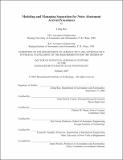| dc.contributor.advisor | John-Paul B. Clarke. | en_US |
| dc.contributor.author | Ren, Liling | en_US |
| dc.contributor.other | Massachusetts Institute of Technology. Dept. of Aeronautics and Astronautics. | en_US |
| dc.date.accessioned | 2008-11-10T19:52:04Z | |
| dc.date.available | 2008-11-10T19:52:04Z | |
| dc.date.copyright | 2007 | en_US |
| dc.date.issued | 2007 | en_US |
| dc.identifier.uri | http://dspace.mit.edu/handle/1721.1/38645 | en_US |
| dc.identifier.uri | http://hdl.handle.net/1721.1/38645 | |
| dc.description | Thesis (Sc. D.)--Massachusetts Institute of Technology, Dept. of Aeronautics and Astronautics, 2007. | en_US |
| dc.description | Includes bibliographical references. | en_US |
| dc.description.abstract | Aircraft noise is a significant concern to communities near airports, and therefore a constraint to the growth of aviation. Advanced noise abatement approach and arrival procedures have been shown in previous studies and in limited implementation to be a cost effective means of achieving near- and medium-term noise reductions. Additionally, these procedures can be employed to reduce fuel bum, emissions, and flight time. However, because of aircraft trajectory variations due to operational uncertainties, it is difficult for air traffic controllers to predict and maintain separation between aircraft. Thus, without proper decision support tools, controllers need to add arbitrarily large buffers, thereby reducing airport throughput. A design and operational framework is proposed to advance the implementation of noise abatement arrival procedures. Under this framework, a target spacing is given at an intermediate metering point to ensure with a certain (limited) probability that the remainder of the noise abatement arrival procedure may be completed without further controller intervention. Small probability exceptions are handled by alternative plans. | en_US |
| dc.description.abstract | (cont.) A design methodology is presented, along with the details of a unique Monte Carlo simulation-based Tool for the Analysis of Separation And Throughput (TASAT) that is used to determine the minimum possible target spacing between aircraft at the metering point. Hence, a smaller separation buffer can be used and traffic throughput can be maintained at a relatively high level. The Monte Carlo simulation-based design tool accounts for operational uncertainties such as differences in aircraft performance, Flight Management System logic, aircraft weight, pilot response, and winds. A mode-decomposition and autoregressive approach was developed to model the stochastic wind variations between flights. Aircraft trajectories from the Monte Carlo simulations (or from radar tracks if they are available) are used within the context of the design methodology to determine target spacing for given desired probability. The utility of the design framework, methodology, and tools was illustrated through simulation analysis and an Area Navigation (RNAV) Continuous Descent Arrival (CDA) flight test at Louisville International Airport. | en_US |
| dc.description.abstract | (cont.) The flight test results were consistent with the model prediction. The research demonstrated that with the developed tools, noise abatement arrival procedures can be implemented to achieve noise reductions and other economic and environmental benefits while maintaining a relatively high level of traffic throughput. Suggestions for the selection of target spacing and the location of the intermediate metering point were provided based on the analysis. | en_US |
| dc.description.statementofresponsibility | by Liling Ren. | en_US |
| dc.format.extent | 186 p. | en_US |
| dc.language.iso | eng | en_US |
| dc.publisher | Massachusetts Institute of Technology | en_US |
| dc.rights | M.I.T. theses are protected by
copyright. They may be viewed from this source for any purpose, but
reproduction or distribution in any format is prohibited without written
permission. See provided URL for inquiries about permission. | en_US |
| dc.rights.uri | http://dspace.mit.edu/handle/1721.1/38645 | en_US |
| dc.rights.uri | http://dspace.mit.edu/handle/1721.1/7582 | en_US |
| dc.subject | Aeronautics and Astronautics. | en_US |
| dc.title | Modeling and managing separation for noise abatement arrival procedures | en_US |
| dc.type | Thesis | en_US |
| dc.description.degree | Sc.D. | en_US |
| dc.contributor.department | Massachusetts Institute of Technology. Department of Aeronautics and Astronautics | |
| dc.identifier.oclc | 163119072 | en_US |
